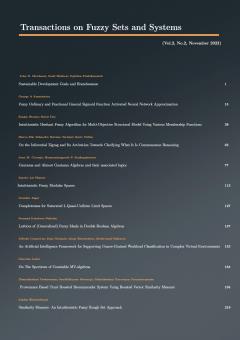Sustainable Development Goals and Homelessness
الموضوعات : Transactions on Fuzzy Sets and Systems
John Mordeson
1
![]() ,
Sunil Mathew
2
,
Sunil Mathew
2
![]() ,
Puzhikunnath Sujithra
3
,
Puzhikunnath Sujithra
3
![]()
1 - Department of Mathematics, Creighton University, USA.
2 - Department of Mathematics, Associate Professor, National Institute of Technology, Calicut, India.
3 - Department of Mathematics, Research Scholar, National Institute of Technology, Calicut, India.
الکلمات المفتاحية: Homelessness, Sustainable development goals, Analytic hierarchy process, Fuzzy similarity measures, Country rankings,
ملخص المقالة :
The United Nation’s Sustainable Development Goals encourage countries to solve many social problems. One of these problems is homelessness. We consider those goals which are most pertinent to homelessness according to [13]. We rank countries with respect to the achievement of these goals. We use fuzzy similarity measures to determine the degree of similarity between these rankings. We use three methods to rank the counties, namely, the Analytic Hierarchy Process, the Guiasu method, and the Yen method. Overall scores of categories in some basic research papers pertaining to Sustainable Development Goals were obtained by using multiplication of the scores of the category’s targets. Multiplication was used to agree with the philosophy that in order for a high score to be obtained, all targets must have a high score. To support this philosophy in the decision process, we use the t-norms bounded difference, algebraic product, and standard intersection as experts. We also suggest a way the techniques used here can be extended to nonstandard analysis
[1] C. Casey and L. Stazen, Seeing homelessness through the Sustainable Development Goals, European Journal of Homelessness, 15(3) (2021), 63-71.
[2] A. P. Dempster, Upper and lower probabilities induced by muiltivaluedmappings, Ann. Math. Stat., 38(2) (1967), 325-528.
[3] A. P. Dempster, Upper and lower probability inferences based on a sample from finite univariant population, Biometrica, 54(3,4) (1967), 515-528.
[4] B. Yaun and G. J. Klir, Fuzzy Sets and Fuzzy Logic, Theory and Applications, Prentice Hall, Upper Saddle Creek River, NJ, (1995).
[5] List of countries by homeless population, Wikipedia (https://en.wikipedia.org/wiki/List-of-sovereign-states-by-homeless-population).
[6] J. N. Mordeson and S. Mathew, Mathematics of Uncertainty for Coping with World Challenges, Climate Change, World Hunger, Modern Slavery, Coronavirus, Human Trafficking, Studies in Systems, Decision and Control 353, Springer, (2021).
[7] J. N. Mordeson and S. Mathew, Fuzzy mathematics and nonstandard analysis: Application to the theory of relativity, Transactions on Fuzzy Sets and Systems, 1(1) (2021).
[8] J. N. Mordeson and S. Mathew, Similarity of Country Rankings on Sustainability Performance, Transactions on Fuzzy Sets and Systems, 2(1) (2023), to appear.
[9] H. C. Wething, J. N. Mordeson and T. C. Clark, A fuzzy mathematical model of nuclear stability, New Math. and Natural Computation , 6 (2010), 119-140.
[10] A. Cutter, D. Osborn and F. Ullah, Universal Sustainable Development Goals, Understanding the Transformational Challenge for Developed Countries, Report of a Study by Stakeholder Forum, (2015), 1-26.
[11] T. L. Saaty, A scaling method for priorities in hierarchical structure, J. Math. Psychol., 15 (1977), 234-281.
[12] T. L. Saaty, The Analytic Hierarchy Process, McGraw Hill, New York, (1980).
[13] J. Salcedo, Homelessness and the SDGs, United Nations Settlements Programme, UN Habitat, (2019).
[14] G. Shafer, A Mathematical Theory of Evidence, Princeton University Press, Princeton, (1976).
[15] Sustainable Development Report, Transformation to achieve the Sustainable Developments Goals, Includes the SDG Index and Dashboards, Bertelamann Stiftung, (2019).
[16] J. Yen, Generalizing the Dempster-Shafer theory to fuzzy sets, In Wang, Z. Klir, G. J. (eds.) Fuzzy Measure Theory Ch. 7, Plenum Press, New York, (1992), 257-283.


